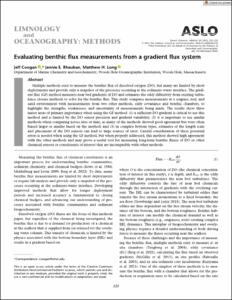Evaluating benthic flux measurements from a gradient flux system.

View/
Average rating
votes
Date
2022Author
Coogan, Jeff
Rheuban, Jennie E.
Long, Matthew H.
Metadata
Show full item recordAbstract
Multiple methods exist to measure the benthic flux of dissolved oxygen (DO), but many are limited by short
deployments and provide only a snapshot of the processes occurring at the sediment–water interface. The gradient
flux (GF) method measures near bed gradients of DO and estimates the eddy diffusivity from existing turbulence
closure methods to solve for the benthic flux. This study compares measurements at a seagrass, reef, and
sand environment with measurements from two other methods, eddy covariance and benthic chambers, to
highlight the strengths, weaknesses, and uncertainty of measurements being made. The results show three
major areas of primary importance when using the GF method: (1) a sufficient DO gradient is critical to use this
method and is limited by the DO sensor precision and gradient variability; (2) it is important to use similar
methods when comparing across sites or time, as many of the methods showed good agreement but were often
biased larger or smalle.....
Journal
Limnology and Oceanography : MethodsVolume
20Page Range
pp.222–232Document Language
enSustainable Development Goals (SDG)
14.aMaturity Level
MatureDOI Original
https://doi.org/10.1002/lom3.10482Citation
Coogan, J., Rheuban, J.E. and Long, M.H. (2022) Evaluating benthic flux measurements from a gradient flux system. Limnology and Oceanography: Methods, 20, pp.222-232. DOI: https://doi.org/10.1002/lom3.10482Collections
The following license files are associated with this item:
Except where otherwise noted, this item's license is described as Attribution-NonCommercial-NoDerivatives 4.0 International
 Repository of community practices in Ocean Research, Applications and Data/Information Management
Repository of community practices in Ocean Research, Applications and Data/Information Management
